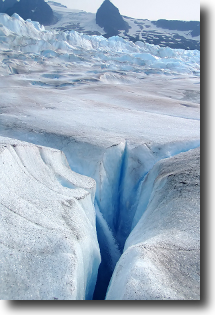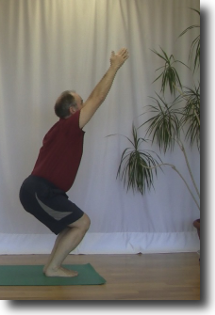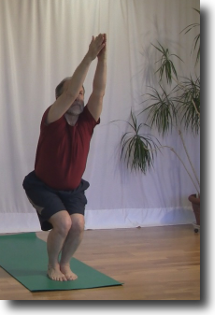Bob’s yoga teacher is with a tour group and they are exploring the glaciers in Jasper National Park. These glaciers are right beside the road. Even though they are close to the road you still have to be careful when you go exploring on top of them.
Suddenly there was a loud cracking sound and a crevasse opened up in the glacier right in front of Bob’s teacher. Another 10 feet and they would have stepped right into it and seriously hurt themselves.
Bob’s teacher told him this story while he was in Utkatasana. Then he went on to explain how Bob could avoid stepping into the crevasse that often formed silently in Utkatasana.
What is Utkatasana
Utkatasana is one of the standing poses that is part of the Ashtanga Yoga practice. It is also the first pose in the Sun Salute B series.
Utkatasana is the Sanskrit name for the pose which translates into English as “Fierce Pose”. There are many other names for this pose in English including: chair pose, zig zag pose, and lightening bolt pose.
From the side you look like you are about to sit in a chair when you suddenly realize that the chair is not there and you reach up with your arms to stop yourself from falling on the floor. This look is why the pose is often called “chair pose”.
This is a difficult pose to hold and requires a lot of strength in your quadriceps the longer you hold it and that is why it is called Utkatasana or “Fierce pose” in Sanskrit.
While the pose may have many names in English it is the same pose and it has the same set of benefits.
Why do Utkatasana
When you do Utkatasana you strengthen your ankles, thighs, calves, and spine. At the same time you stretch your shoulder and chest muscles. This pose stimulates your abdominal organs, diaphragm and heart and it helps to reduce flat feet.
There are a lot of benefits when you do this pose and thankfully this is one of the easier poses to get in to. There is no binding and no twisting involved.
How to do Utkatasana
First of all you start in Tadasana, standing tall with your big toes touching and a slight gap at your heels. Your arms are resting at your side and you are gazing straight ahead.
From here you exhale, lower your hips, bend your knees, lean forward and lift your arms up over your head. You should be able to see your toes just beyond your knees. If you do not see your toes then move your hips a little further back and lean a little further forward.
Your arms are in the right place when there is a straight line from your wrists through your elbows and shoulders to your hips. Your arms are straight and your palms are touching. At the same time move your shoulders down your back towards your hips.
Tuck your tail bone in slightly causing your hips to tip back wards a little bit. Once you get your hips setup lower them a little bit more towards the floor.
Bring your gaze towards your thumbs. Avoid compressing the neck when you do this by looking through your eyebrows.
You hold here for several breaths.
Now that Bob is in the pose he is wondering where the crevasse is.
Where does the crevasse appear
A crevasse is a split or a gap in the surface of the glacier. In Utkatasana the crevasse shows up between Bob’s knees when he bends his legs and lowers his hips towards the floor. When he is standing tall his knees are together but when he lowers his hips and bend his legs the gap appears. It is not a very big gap, but still this is a problem.
Why is this gap a problem
This gap between the knees means that the knee joint is not correctly aligned and that there will be an unequal strain on the ligaments and tendons of the knee joint. There is a bit of a twist going on in the knee joint as a result of this crevasse that has appeared.
Unlike the crevasse that appeared in the glacier which can not be closed, the one between Bob’s knees can be fixed.
How to fix this problem
To make the gap between Bob’s knees go away, his teacher tells him to check the position of his feet. Make sure that your big toes are touching each other and that there is a small space between your heels. If necessary you increase the space between your heels until your knees are touching.
As your knees get closer together the unequal strain on the ligaments and tendons of the knee joint will go away.
Next Step
The next time you do Utkatasana check to see if you have created a crevasse between your knees and close that gap by fixing the alignment of your feet.






